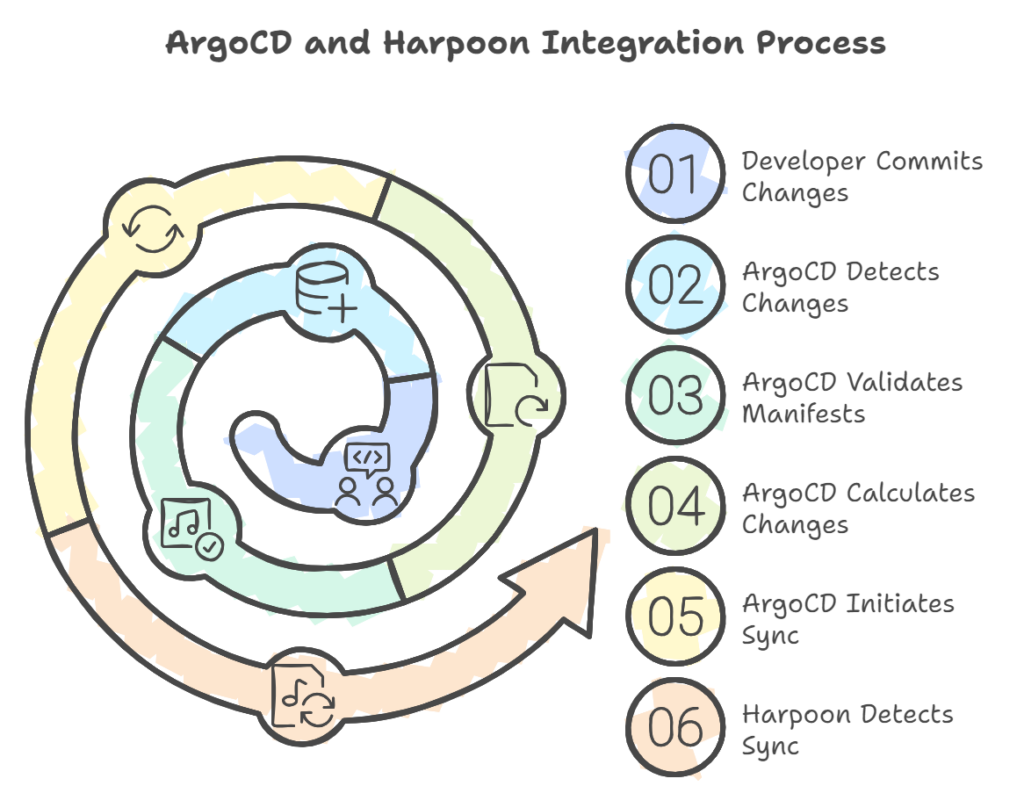
In the modern software development landscape, continuous integration and continuous deployment (CI/CD) are crucial for delivering high-quality applications rapidly and reliably. This guide explores the powerful integration of ArgoCD and Harpoon, showing you how to create a sophisticated, automated deployment pipeline that maintains consistency and reliability across your Kubernetes infrastructure.
Understanding the Core Components
ArgoCD
- A GitOps continuous delivery tool that automates Kubernetes deployments
- Monitors and syncs application states defined in Git with the live environment
- Provides declarative configuration management
Harpoon
- Complements ArgoCD by handling dynamic deployments and scaling
- Manages cluster reconstruction based on manifest changes
- Ensures efficient resource utilization and deployment stability
Architecture and Workflow

The Integration Flow

1. Change Initiation
- Developer commits changes to Git repository
- ArgoCD detects changes in manifest files
2. Sync Process
- ArgoCD validates new manifests
- Calculates required changes
- Initiates sync process
3. Harpoon’s Role
- Detects ArgoCD sync activities
- Manages dynamic scaling and reconstruction
- Ensures smooth transition during changes
Navigating the Harpoon User Interface
Before diving into the practical implementation, let’s familiarize ourselves with Harpoon’s interface, which you’ll be working with throughout the deployment process.
1. Cluster and Service Information

When working with Harpoon, you’ll have access to important cluster information:
- Service name configuration
- Cluster IP address (e.g., 172.20.190.254)
- DNS information for your AWS deployment
- Namespace details (e.g., harpoon-99517-40126)
2. Deployment Configuration

The Harpoon deployment YAML shows several crucial configurations:
API Version and Deployment Kind.
Metadata including:
- Kubernetes revision annotations
- Creation timestamp
- Unique identifiers
Deployment specifications:
- Progress deadline (600 seconds)
- Replica count
- Revision history limits
- Rolling update strategy (25% maxSurge and maxUnavailable)
3. Build and Deploy Interface

The main Harpoon interface demonstrates its powerful multi-service orchestration capabilities:
- Database Service (MongoDB)
- Version selection (set to “latest”)
- Simple deployment controls
- Direct database configuration management
- Backend Service (harpoondemoback)
- Branch selection (main branch)
- Commit reference tracking
- Build and Deploy pipeline controls
- Configuration management for backend services
- Frontend Service (harpoondemofront)
- Separate branch management (dev branch)
- Independent commit tracking
- Dedicated build and deploy controls
- Frontend-specific configuration options
- Global Controls and Configuration
- Cluster state monitoring (showing “Up” status)
- Project selection dropdown
- Saved configuration values
- Right-side panel providing access to:
- Config maps
- Volume management
- Secret configuration
- Ingress route setup
- Node configuration
This interface showcases Harpoon’s ability to manage complex, multi-service architectures while maintaining clear separation and control over each component.
Key Features to Note
- Service Independence
- Each service can be managed independently
- Different branches can be used for different services
- Separate build and deploy cycles
- Configuration Management
- Centralized config value tracking
- Shared resource management
- Integrated secrets handling
- Monitoring and Control
- Real-time cluster state monitoring
- Individual service build status
- Unified deployment overview
This comprehensive interface demonstrates how Harpoon simplifies the management of complex, multi-service applications while maintaining granular control over each component. With this understanding of the UI, let’s proceed to the practical implementation.
Practical Implementation
First, install ArgoCD in your cluster:
kubectl create namespace argocd
kubectl apply -n argocd -f https://raw.githubusercontent.com/argoproj/argo-cd/stable/manifests/install.yamlInstall Harpoon:
bash
kubectl apply -f https://raw.githubusercontent.com/harpoon/harpoon/main/deploy.yaml2. Configure ArgoCD Application:
yaml
argocd-application.yaml
apiVersion: argoproj.io/v1alpha1
kind: Application
metadata:
name: sample-app
namespace: argocd
spec:
project: default
source:
repoURL: https://github.com/your-org/your-repo.git
targetRevision: HEAD
path: kubernetes/manifests
destination:
server: https://kubernetes.default.svc
namespace: default
syncPolicy:
automated:
prune: true
selfHeal: true3. Define Your Application Manifests
yaml
deployment.yaml
apiVersion: apps/v1
kind: Deployment
metadata:
name: sample-app
namespace: default
spec:
replicas: 3
selector:
matchLabels:
app: sample-app
template:
metadata:
labels:
app: sample-app
spec:
containers:
- name: app-container
image: myapp:latest
env:
- name: ENVIRONMENT
value: "production"Understanding Change Propagation
Manifest Changes and Reconstruction
When changes occur in manifests, the following sequence takes place:
1. Git Update
bash
git add deployment.yaml
git commit -m "Update configuration"
git push origin main2. ArgoCD Detection
- ArgoCD polls Git repository
- Detects configuration changes
- Initiates sync process
3. Harpoon Reconstruction
- Monitors ArgoCD sync events
- Evaluates resource requirements
- Manages scaling and deployment updates
Example: Scaling Application
1. Update Manifest
yaml
spec:
replicas: 5 Changed from 3 to 52. Commit Changes
bash
git add deployment.yaml
git commit -m "Scale to 5 replicas"
git push origin main3. Verify Changes
kubectl get deployments sample-app
argocd app get sample-app
Handling Configuration Changes
Environment Variables
When updating environment variables:
yaml
spec:
template:
spec:
containers:
- name: app-container
env:
- name: NEW_FEATURE_FLAG
value: "enabled"Harpoon manages this change by:
1. Detecting the configuration update
2. Implementing rolling updates
3. Maintaining service availability
Resource Allocation
yaml
spec:
template:
spec:
containers:
- name: app-container
resources:
requests:
memory: "256Mi"
cpu: "500m"
limits:
memory: "512Mi"
cpu: "1000m"Testing and Validation
1. Sync Status Verification
argocd app get sample-app2. Deployment Health Check
kubectl describe deployment sample-app
kubectl get pods -l app=sample-app3. Resource Validation
kubectl top pods -l app=sample-appBest Practices
1. Version Control
- Use semantic versioning for images
- Maintain clear Git history
- Document all configuration changes
2. Resource Management
- Set appropriate resource limits
- Implement horizontal pod autoscaling
- Monitor cluster capacity
3. Security
yaml
Add network policies
apiVersion: networking.k8s.io/v1
kind: NetworkPolicy
metadata:
name: sample-app-policy
spec:
podSelector:
matchLabels:
app: sample-app
policyTypes:
- Ingress
- Egress
4. Monitoring Setup
Implement comprehensive monitoring:
yaml
prometheus-servicemonitor.yaml
apiVersion: monitoring.coreos.com/v1
kind: ServiceMonitor
metadata:
name: sample-app-monitor
spec:
selector:
matchLabels:
app: sample-app
endpoints:
- port: metricsTroubleshooting Guide
Common Issues and Solutions
1. Sync Failures
argocd app logs sample-app
kubectl logs -n argocd deployment/argocd-application-controller2. Resource Constraints
kubectl describe nodes | grep -A 5 "Allocated resources"3. Network Issues
kubectl exec -it sample-app-pod -- nc -vz service-name 80Advanced Topics
1. Blue-Green Deployments
yaml
spec:
strategy:
type: RollingUpdate
rollingUpdate:
maxSurge: 1
maxUnavailable: 02. Canary Deployments
Implement progressive traffic shifting:
yaml
apiVersion: networking.istio.io/v1alpha3
kind: VirtualService
metadata:
name: sample-app
spec:
hosts:
- sample-app
http:
- route:
- destination:
host: sample-app-v1
weight: 90
- destination:
host: sample-app-v2
weight: 10
The integration of ArgoCD and Harpoon creates a robust, automated deployment pipeline that combines the benefits of GitOps with dynamic infrastructure management. This setup provides:
- Automated deployment processes
- Consistent configuration management
- Reliable scaling and updates
- Clear audit trail of changes
Remember to always test changes in a development environment first and maintain comprehensive documentation of your deployment processes.



